-
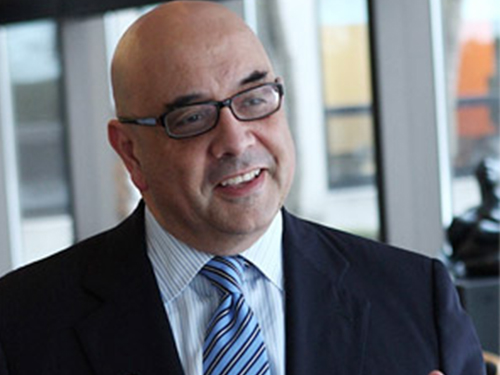 An Artist and Scientist, the Dean of Northwestern University speaks at KAIST
How does an abstract artist look at the world of science? Can art enhance scientific inquiry?
The Department of Chemical and Biomolecular Engineering (CBE), KAIST, invited Professor Julio Mario Ottino to speak at its fourth Annual KAIST CBE Global Distinguished Lectureship from the 15th to 16th October. Professor Ottino is the Dean of the Robert R. McCormick School of Engineering and Applied Science at Northwestern University.
Professor Ottino is a famous artist as well as a scientist. He pursues his disciplines in engineering and art as ways by which an artistic value and scientific truth can coexist. By merging these disciplines, he is praised for adopting balanced engineering education that emphasizes analytical skills and creativity at Northwestern University.
The lecture took place over two days. The topic of the first day was “Creativity” and the next day, “Formalism in Science.”
On the first day, Professor Ottino spoke about “Creativity in Science, Art, and Technology -- How art is separated from science.” He argues that as creativity is essential in art, science, and technology, artistic creativity can help develop scientific and technological creativity.
The next lecture featured “Mixing of Fluids and Solids: Parallels, Divergences, and Lessons.”
He emphasized that the birth of mixing of fluids and researches on granular matter and segregation offered valuable insights and lessons. Although these two topics have developed in different ways, he laid down some examples on how scientific theories have progressed under formalism.
2014.10.16 View 9334
An Artist and Scientist, the Dean of Northwestern University speaks at KAIST
How does an abstract artist look at the world of science? Can art enhance scientific inquiry?
The Department of Chemical and Biomolecular Engineering (CBE), KAIST, invited Professor Julio Mario Ottino to speak at its fourth Annual KAIST CBE Global Distinguished Lectureship from the 15th to 16th October. Professor Ottino is the Dean of the Robert R. McCormick School of Engineering and Applied Science at Northwestern University.
Professor Ottino is a famous artist as well as a scientist. He pursues his disciplines in engineering and art as ways by which an artistic value and scientific truth can coexist. By merging these disciplines, he is praised for adopting balanced engineering education that emphasizes analytical skills and creativity at Northwestern University.
The lecture took place over two days. The topic of the first day was “Creativity” and the next day, “Formalism in Science.”
On the first day, Professor Ottino spoke about “Creativity in Science, Art, and Technology -- How art is separated from science.” He argues that as creativity is essential in art, science, and technology, artistic creativity can help develop scientific and technological creativity.
The next lecture featured “Mixing of Fluids and Solids: Parallels, Divergences, and Lessons.”
He emphasized that the birth of mixing of fluids and researches on granular matter and segregation offered valuable insights and lessons. Although these two topics have developed in different ways, he laid down some examples on how scientific theories have progressed under formalism.
2014.10.16 View 9334 -
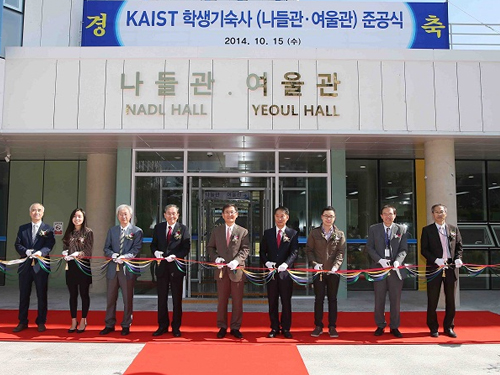 KAIST Opens a New Residence Hall for Students
KAIST has made a great addition to improve life for students on campus.
The faculty and students celebrated the completion of a new dormitory for students on October 15, 2014. About 50 people including President Steve Kang of KAIST, the Dean of the Office of Student Affairs and Policy, and the Dean of the Office of Student Life, attended the ceremony.
The building can accommodate up to 600 students at a time, housing such facilities as 2-or 4-person rooms, meeting rooms, gyms, and laundry rooms. The dormitory is environmentally friendly, with 60% of its heat and cooling system supported by geothermal energy.
Its construction took 18 months, from January 2013 to August 2014, at a cost of 175 million US dollars.
2014.10.15 View 6554
KAIST Opens a New Residence Hall for Students
KAIST has made a great addition to improve life for students on campus.
The faculty and students celebrated the completion of a new dormitory for students on October 15, 2014. About 50 people including President Steve Kang of KAIST, the Dean of the Office of Student Affairs and Policy, and the Dean of the Office of Student Life, attended the ceremony.
The building can accommodate up to 600 students at a time, housing such facilities as 2-or 4-person rooms, meeting rooms, gyms, and laundry rooms. The dormitory is environmentally friendly, with 60% of its heat and cooling system supported by geothermal energy.
Its construction took 18 months, from January 2013 to August 2014, at a cost of 175 million US dollars.
2014.10.15 View 6554 -
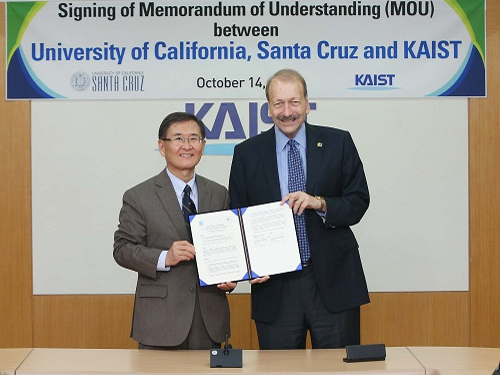 KAIST and University of California, Santa Cruz, Agree to Cooperate
KAIST and the University of California in Santa Cruz signed a memorandum of understanding (MOU) at the KAIST campus on October 14, 2014.
The two institutions agreed to cooperate in the following four areas:
- Research collaboration in genomics and biology
- Academic exchanges in engineering and information communication technology
- Student and faculty exchange programs
- Joint academic workshops and seminars
Following the MOU signing ceremony, Dr. George Blumenthal, the Chancellor of UC Santa Cruz, held a special seminar for KAIST students and faculty, during which he shared some of the success stories made through UC Santa Cruz’s close cooperation with companies in Silicon Valley.
President Steve Kang of KAIST praised the MOU saying, “KAIST and UC Santa Cruz have top-notch research professionals, and the MOU will reinforce their research capability. We hope that the two universities will carry out many research projects that bring significant impact on the world.”
UC Santa Cruz was established in 1965 as a public research university committed to undergraduate education. The university has a total student population of 16,000 (15,375 undergraduates and 1,378 graduates). Offering 60 undergraduate majors, UC Santa Cruz's faculty includes six recipients of Pulitzer Prizes and five MacArthur Genius Awards. The university was ranked the 2nd in the world for research influence in 2012-2013 Times Higher Education rankings.
2014.10.15 View 9111
KAIST and University of California, Santa Cruz, Agree to Cooperate
KAIST and the University of California in Santa Cruz signed a memorandum of understanding (MOU) at the KAIST campus on October 14, 2014.
The two institutions agreed to cooperate in the following four areas:
- Research collaboration in genomics and biology
- Academic exchanges in engineering and information communication technology
- Student and faculty exchange programs
- Joint academic workshops and seminars
Following the MOU signing ceremony, Dr. George Blumenthal, the Chancellor of UC Santa Cruz, held a special seminar for KAIST students and faculty, during which he shared some of the success stories made through UC Santa Cruz’s close cooperation with companies in Silicon Valley.
President Steve Kang of KAIST praised the MOU saying, “KAIST and UC Santa Cruz have top-notch research professionals, and the MOU will reinforce their research capability. We hope that the two universities will carry out many research projects that bring significant impact on the world.”
UC Santa Cruz was established in 1965 as a public research university committed to undergraduate education. The university has a total student population of 16,000 (15,375 undergraduates and 1,378 graduates). Offering 60 undergraduate majors, UC Santa Cruz's faculty includes six recipients of Pulitzer Prizes and five MacArthur Genius Awards. The university was ranked the 2nd in the world for research influence in 2012-2013 Times Higher Education rankings.
2014.10.15 View 9111 -
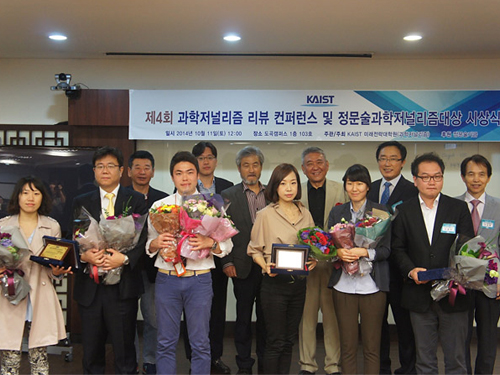 KAIST's Masters of Science Journalism Presents the 4th Annual Moon-Sul Chung Award
The Masters of Science Journalism (MSJ) program at the Graduate School of Future Strategy, KAIST, hosted a conference and presented its fourth annual Moon-Sul Chung Award to the Hankyoreh newspaper at KAIST’s Seoul campus on October 11, 2014.
MSJ organized the conference to review major issues reported in the Korean news in the context of the sciences, for example, how the Korean media covered the tragic accident of the Sewol Ferry, a passenger ship that capsized and eventually sank with hundreds of passengers on board in the waters off the southern coast of Korea on April 16, 2014. Participants of the conference discussed the approaches taken by the media to report science-related issues such as mechanical problems of the ship and technical errors made by the operator.
MSJ conferred its annual award to a Hankyoreh news team which covered the Sewol incident. The award is named for Moon-Sul Chung, a philanthropist who created a scholarship fund for the school in 2011 to recognize news organizations that have striven to report social issues in a fair and balanced manner.
2014.10.14 View 6981
KAIST's Masters of Science Journalism Presents the 4th Annual Moon-Sul Chung Award
The Masters of Science Journalism (MSJ) program at the Graduate School of Future Strategy, KAIST, hosted a conference and presented its fourth annual Moon-Sul Chung Award to the Hankyoreh newspaper at KAIST’s Seoul campus on October 11, 2014.
MSJ organized the conference to review major issues reported in the Korean news in the context of the sciences, for example, how the Korean media covered the tragic accident of the Sewol Ferry, a passenger ship that capsized and eventually sank with hundreds of passengers on board in the waters off the southern coast of Korea on April 16, 2014. Participants of the conference discussed the approaches taken by the media to report science-related issues such as mechanical problems of the ship and technical errors made by the operator.
MSJ conferred its annual award to a Hankyoreh news team which covered the Sewol incident. The award is named for Moon-Sul Chung, a philanthropist who created a scholarship fund for the school in 2011 to recognize news organizations that have striven to report social issues in a fair and balanced manner.
2014.10.14 View 6981 -
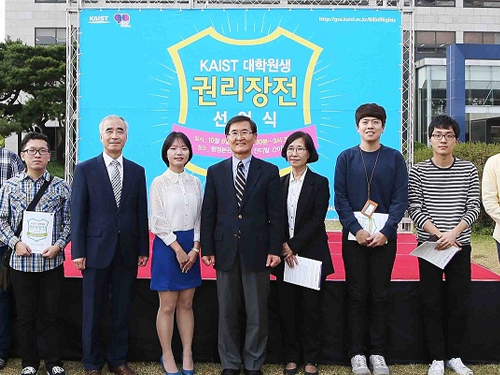 KAIST Introduces a Student Bill of Rights
The Graduate Student Association at KAIST (GSA) established a Bill of Rights for students, outlining student basic beliefs, rights, and obligations. This was the first time for Korean university students to create their own Bill of Rights.
The Bill consists of a total of 21 articles. The preamble of the Bill states individual rights for students, confirming that the Constitution of the Republic of Korea extends to the members of the KAIST community. The Articles stipulate the rights and obligations of students, covering such rights as healthcare, marriage, maternal care, privacy protection, study and research opportunities, and security.
The GSA held a ceremony to inform KAIST members of the Bill of Rights in front of the Main Administration building on October 6, 2014. Approximately 100 students and faculty members, including President Steve Kang, joined the ceremony. They expressed support for students’ efforts to build a better environment conducive to study and research.
Yeon-Ju Kim, the GSA President, said, “The Student Bill of Rights will serve as the first step to raise awareness about our rights and obligations. The Student Association will continue making efforts to provide KAIST students with an opportunity to study and live in a happier and healthier environment.”
2014.10.11 View 6892
KAIST Introduces a Student Bill of Rights
The Graduate Student Association at KAIST (GSA) established a Bill of Rights for students, outlining student basic beliefs, rights, and obligations. This was the first time for Korean university students to create their own Bill of Rights.
The Bill consists of a total of 21 articles. The preamble of the Bill states individual rights for students, confirming that the Constitution of the Republic of Korea extends to the members of the KAIST community. The Articles stipulate the rights and obligations of students, covering such rights as healthcare, marriage, maternal care, privacy protection, study and research opportunities, and security.
The GSA held a ceremony to inform KAIST members of the Bill of Rights in front of the Main Administration building on October 6, 2014. Approximately 100 students and faculty members, including President Steve Kang, joined the ceremony. They expressed support for students’ efforts to build a better environment conducive to study and research.
Yeon-Ju Kim, the GSA President, said, “The Student Bill of Rights will serve as the first step to raise awareness about our rights and obligations. The Student Association will continue making efforts to provide KAIST students with an opportunity to study and live in a happier and healthier environment.”
2014.10.11 View 6892 -
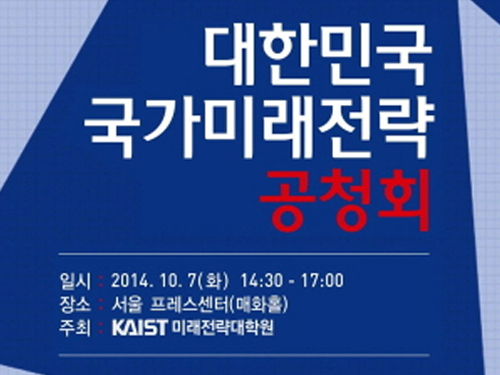 The KAIST Graduate School of Future Strategy Holds a Conference on Strategies for National Development
The Graduate School of Future Strategy (GSFS) at KAIST hosted a conference on strategies to advance Korea further. The conference took place at the Seoul Press Center on October 7, 2014.
GSFS organized the conference to discuss important issues facing Korea such as the global economic crisis, political instability in Northeast Asia, and Korea's aging population as well as ways to resolve these issues through innovations in science and technology.
Seven panelists, mostly professors from GSFS, presented papers on strategies proposed from various perspectives intended to make Korea economically, politically, and culturally stronger in the future.
Professor Kwang-Hyung Lee, Dean of GSFS, said that the results of the conference will be published as a report, to be entitled “Building a Creative Nation Based upon Peace in Asia,” and will be submitted to the Korean government.
2014.10.10 View 6581
The KAIST Graduate School of Future Strategy Holds a Conference on Strategies for National Development
The Graduate School of Future Strategy (GSFS) at KAIST hosted a conference on strategies to advance Korea further. The conference took place at the Seoul Press Center on October 7, 2014.
GSFS organized the conference to discuss important issues facing Korea such as the global economic crisis, political instability in Northeast Asia, and Korea's aging population as well as ways to resolve these issues through innovations in science and technology.
Seven panelists, mostly professors from GSFS, presented papers on strategies proposed from various perspectives intended to make Korea economically, politically, and culturally stronger in the future.
Professor Kwang-Hyung Lee, Dean of GSFS, said that the results of the conference will be published as a report, to be entitled “Building a Creative Nation Based upon Peace in Asia,” and will be submitted to the Korean government.
2014.10.10 View 6581 -
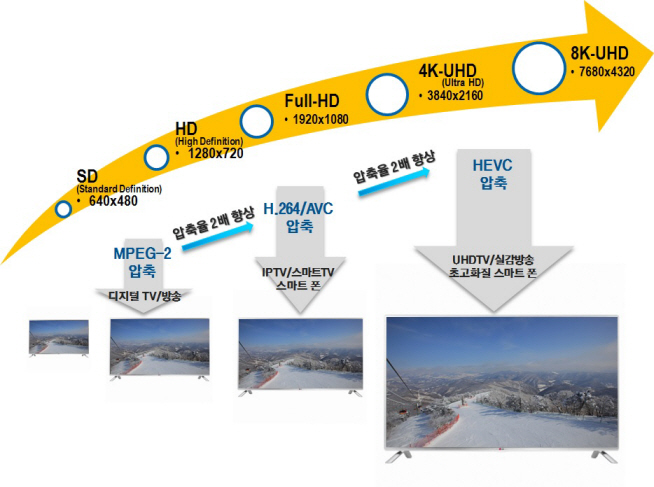 KAIST Registers an Internationally Recognized Standard Patent
A video compression technology, jointly developed by Professor Mun-Chul Kim of the Department of Electrical Engineering at KAIST, the Electronics and Telecommunications Research Institute (ETRI), and the Korean Broadcasting System (KBS), is registered internationally as the standard patent in the next-generation High Efficiency Video Coding (HEVC).
HEVC (H.265) is an international technology standard that compresses large image data for Ultra High Definition (UHD) televisions and smartphones. It has the twice the compression efficiency as that of H.264/AVC which is most commonly used for processing full HD sources. This means that it is able to compress a video file to half the size while maintaining the same image quality.
Although the related market is at a nascent stage, HEVC technology has already been applied to the latest version of televisions and smartphones. Experts predict that the market will grow to USD 200 billion by 2016, and KAIST is expected to receive a royalty payment of USD 9.3 million from this patent.
The International Organization for Standardization (ISO/IEC) established the HEVC standard in January 2013. Also, an international patent pool licensing corporation, MPEG LA announced the HEVC standard patent pool on September 29, 2014.
Professor Joongmyeon Bae, Dean of the Office of University-Industry Cooperation (OUIC) of KAIST, said, “This is an unprecedented case for Korea whereby a core technology developed by a university became an international standard, which has a vast impact on the market.”
President of KAIST, Steve Kang commented, “With its advanced technology, KAIST joined the HEVC standard patent pool as one of the 23 founding members along with Apple, Siemens, and NEC. This is a remarkable achievement.”
Picture 1: Improvements in video compression technology
Picture 2: Comparison of different screen resolutions
2014.10.09 View 14197
KAIST Registers an Internationally Recognized Standard Patent
A video compression technology, jointly developed by Professor Mun-Chul Kim of the Department of Electrical Engineering at KAIST, the Electronics and Telecommunications Research Institute (ETRI), and the Korean Broadcasting System (KBS), is registered internationally as the standard patent in the next-generation High Efficiency Video Coding (HEVC).
HEVC (H.265) is an international technology standard that compresses large image data for Ultra High Definition (UHD) televisions and smartphones. It has the twice the compression efficiency as that of H.264/AVC which is most commonly used for processing full HD sources. This means that it is able to compress a video file to half the size while maintaining the same image quality.
Although the related market is at a nascent stage, HEVC technology has already been applied to the latest version of televisions and smartphones. Experts predict that the market will grow to USD 200 billion by 2016, and KAIST is expected to receive a royalty payment of USD 9.3 million from this patent.
The International Organization for Standardization (ISO/IEC) established the HEVC standard in January 2013. Also, an international patent pool licensing corporation, MPEG LA announced the HEVC standard patent pool on September 29, 2014.
Professor Joongmyeon Bae, Dean of the Office of University-Industry Cooperation (OUIC) of KAIST, said, “This is an unprecedented case for Korea whereby a core technology developed by a university became an international standard, which has a vast impact on the market.”
President of KAIST, Steve Kang commented, “With its advanced technology, KAIST joined the HEVC standard patent pool as one of the 23 founding members along with Apple, Siemens, and NEC. This is a remarkable achievement.”
Picture 1: Improvements in video compression technology
Picture 2: Comparison of different screen resolutions
2014.10.09 View 14197 -
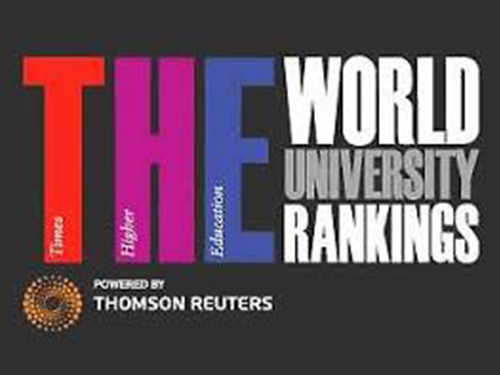 KAIST Ranks 26th in Engineering & Technology and 52nd overall in the Times Higher Education World University Rankings 2014-2015
The 2014-2015 Times Higher Education (THE) World University Rankings were released on October 1, 2014. KAIST took 52nd place in the overall rankings and 26th in the field of engineering and technology.
THE used 13 performance indicators to evaluate universities, grouping them into five areas of teaching, research, citations, industry income, and international outlook.
In recent years, KAIST has seen steady improvements in areas of research, citations, and international outlook. In addition to KAIST, two Korean universities, Seoul National University (50th) and Pohang University of Science and Technology (66th), were included within the top 100 universities.
For details, please visit:
http://www.timeshighereducation.co.uk/world-university-rankings/2014-15/world-ranking.
2014.10.03 View 9348
KAIST Ranks 26th in Engineering & Technology and 52nd overall in the Times Higher Education World University Rankings 2014-2015
The 2014-2015 Times Higher Education (THE) World University Rankings were released on October 1, 2014. KAIST took 52nd place in the overall rankings and 26th in the field of engineering and technology.
THE used 13 performance indicators to evaluate universities, grouping them into five areas of teaching, research, citations, industry income, and international outlook.
In recent years, KAIST has seen steady improvements in areas of research, citations, and international outlook. In addition to KAIST, two Korean universities, Seoul National University (50th) and Pohang University of Science and Technology (66th), were included within the top 100 universities.
For details, please visit:
http://www.timeshighereducation.co.uk/world-university-rankings/2014-15/world-ranking.
2014.10.03 View 9348 -
 KAIST Co-owns the HEVC Patent Portfolio License
MPEG LA, LLC, a firm based in Denver, Colorado, which licenses patent pools covering essential patents required for the use of video coding technology, such as MPEG-2, MPEG-4 Visual (Part 2), and HEVC/H.264, announced the availability of the High Efficiency Video Coding (HEVC) Patent Portfolio License on September 29, 2014.
The HEVC standard, also known as H.265 and MPEG-H Part 2, is necessary to improve video coding and transmission efficiency for the Internet, televisions, and mobile gadgets with increased speed and capacity.
Through the portfolio license, users can easily obtain patent rights required for the HEVC standard in a single transaction, instead of negotiating separate licenses from multiple patent holders.
A total of 23 enterprises currently own essential HEVC patents. KAIST is the only Korean university among the joint patent owners. Collaborating with the Korea Broadcasting System (KBS) and the Electronics and Telecommunications Research Institute (ETRI), Professor Mun-Chul Kim of the Electrical Engineering Department at KAIST developed one of the core patents.
For a link to a press release distributed by MPEG LA, LLC, please see:
MPEG LA, LLC, September 29, 2014
"MPEG LA, LLC Offers HEVC Patent Portfolio License"
http://www.mpegla.com/main/Pages/Media.aspx
2014.10.02 View 14680
KAIST Co-owns the HEVC Patent Portfolio License
MPEG LA, LLC, a firm based in Denver, Colorado, which licenses patent pools covering essential patents required for the use of video coding technology, such as MPEG-2, MPEG-4 Visual (Part 2), and HEVC/H.264, announced the availability of the High Efficiency Video Coding (HEVC) Patent Portfolio License on September 29, 2014.
The HEVC standard, also known as H.265 and MPEG-H Part 2, is necessary to improve video coding and transmission efficiency for the Internet, televisions, and mobile gadgets with increased speed and capacity.
Through the portfolio license, users can easily obtain patent rights required for the HEVC standard in a single transaction, instead of negotiating separate licenses from multiple patent holders.
A total of 23 enterprises currently own essential HEVC patents. KAIST is the only Korean university among the joint patent owners. Collaborating with the Korea Broadcasting System (KBS) and the Electronics and Telecommunications Research Institute (ETRI), Professor Mun-Chul Kim of the Electrical Engineering Department at KAIST developed one of the core patents.
For a link to a press release distributed by MPEG LA, LLC, please see:
MPEG LA, LLC, September 29, 2014
"MPEG LA, LLC Offers HEVC Patent Portfolio License"
http://www.mpegla.com/main/Pages/Media.aspx
2014.10.02 View 14680 -
 KAIST's Artist Residency Program Recruits Third Round Applicants
KAIST is accepting applications for the third Artist Residency Program, “The Endless Road,” from September 22, 2014 to October 21, 2014.
Through the program, KAIST has supported emerging and promising artists, writers in particular, such as novelists, poets, storytellers, and playwrights, to live on the campus and encourage them to interact with students and faculty. Originally initiated to integrate art and science and to seek synergistic effects that benefit both communities, the program has been well received by artists and scientists.
A total of three writers will be selected, and they will receive a stipend of USD 753.00 per month for six months. The program is available only in Korean.
2014.10.01 View 6324
KAIST's Artist Residency Program Recruits Third Round Applicants
KAIST is accepting applications for the third Artist Residency Program, “The Endless Road,” from September 22, 2014 to October 21, 2014.
Through the program, KAIST has supported emerging and promising artists, writers in particular, such as novelists, poets, storytellers, and playwrights, to live on the campus and encourage them to interact with students and faculty. Originally initiated to integrate art and science and to seek synergistic effects that benefit both communities, the program has been well received by artists and scientists.
A total of three writers will be selected, and they will receive a stipend of USD 753.00 per month for six months. The program is available only in Korean.
2014.10.01 View 6324 -
 KAIST's Education Donation Center Holds a Workshop
KAIST's Education Donation Center hosted a workshop on September 26, 2014 at the Munji campus, which included 60 officials from the Ministry of Education, the Republic of Korea, as well as from the provincial governments of Chungcheong and Kangwon.
The workshop was organized to discuss how to best deliver donations to support education in the two provinces and to better connect educational organizations and schools in the regions.
The center was created in July 2014 at KAIST to raise donations for education, implementing such activities as identifying potential donors, matching donors with beneficiaries, and building donation networks.
2014.10.01 View 6444
KAIST's Education Donation Center Holds a Workshop
KAIST's Education Donation Center hosted a workshop on September 26, 2014 at the Munji campus, which included 60 officials from the Ministry of Education, the Republic of Korea, as well as from the provincial governments of Chungcheong and Kangwon.
The workshop was organized to discuss how to best deliver donations to support education in the two provinces and to better connect educational organizations and schools in the regions.
The center was created in July 2014 at KAIST to raise donations for education, implementing such activities as identifying potential donors, matching donors with beneficiaries, and building donation networks.
2014.10.01 View 6444 -
 Thomson Reuters Nominates Distinguished Professor Ryong Ryoo for Its 2014 Nobel Citation Laureates in Chemistry
The Intellectual Property & Science business of Thomson Reuters announced on September 25th its “2014 Citation Laureates,” a list of candidates considered likely to win the Nobel Prize in the fields of physics, chemistry, physiology or medicine, and economics. The annual Thomson Reuters Citation Laureates will be recognized in perpetuity as contenders for a Nobel Prize.
Distinguished Professor Ryong Ryoo of the Department of Chemistry, KAIST, has been nominated for the 2014 Thomson Reuters Citation Laureates in Chemistry. He is the first Korean scientist who has made the list. In addition to Professor Ryoo, seven other scientists were selected as possible contenders for the 2014 Nobel Prize in Chemistry, or in the future.
Professor Ryoo was named alongside Charles T. Kresge, Chief Technology Officer of Saudi Aramco, Dhahran, and Galen D. Stucky, Professor of the Department Chemistry and Biochemistry at the University of California, Santa Barbara, for their research on the design of functional mesoporous materials (http://sciencewatch.com/nobel/2014-predictions/chemistry-laureates). Mesoporous materials have high surface areas with narrow pore-sized distribution and tunable pores diameters, offering promising properties and applications in various areas including adsorption, separation, sensing, and catalysis.
Professor Ryoo has focused his research interest in the synthesis of new functional nanoporous materials such as hierarchical zeolites, mesoporous silicas, carbons, and organic-inorganic composite materials that can be used for advanced applications in the production of alternative energy sources and in green chemical processes.
According to the press release by the Thomson Reuters, the list of the 2014 Nobel predictions includes 27 researchers representing 27 distinct academic and research organizations across nine different countries.
The annual Thomson Reuters Citation Laureates study is based on the analysis of proprietary data from the research and citation database, identifying the most influential researchers in the categories of chemistry, physics, physiology or medicine, and economics. Since its inception in 2002, the study has accurately forecasted 35 Nobel Prize winners. For the full text of the press release, please go to: http://thomsonreuters.com/press-releases/092014/2014-nobel-laureates-predictions.
2014.09.29 View 12601
Thomson Reuters Nominates Distinguished Professor Ryong Ryoo for Its 2014 Nobel Citation Laureates in Chemistry
The Intellectual Property & Science business of Thomson Reuters announced on September 25th its “2014 Citation Laureates,” a list of candidates considered likely to win the Nobel Prize in the fields of physics, chemistry, physiology or medicine, and economics. The annual Thomson Reuters Citation Laureates will be recognized in perpetuity as contenders for a Nobel Prize.
Distinguished Professor Ryong Ryoo of the Department of Chemistry, KAIST, has been nominated for the 2014 Thomson Reuters Citation Laureates in Chemistry. He is the first Korean scientist who has made the list. In addition to Professor Ryoo, seven other scientists were selected as possible contenders for the 2014 Nobel Prize in Chemistry, or in the future.
Professor Ryoo was named alongside Charles T. Kresge, Chief Technology Officer of Saudi Aramco, Dhahran, and Galen D. Stucky, Professor of the Department Chemistry and Biochemistry at the University of California, Santa Barbara, for their research on the design of functional mesoporous materials (http://sciencewatch.com/nobel/2014-predictions/chemistry-laureates). Mesoporous materials have high surface areas with narrow pore-sized distribution and tunable pores diameters, offering promising properties and applications in various areas including adsorption, separation, sensing, and catalysis.
Professor Ryoo has focused his research interest in the synthesis of new functional nanoporous materials such as hierarchical zeolites, mesoporous silicas, carbons, and organic-inorganic composite materials that can be used for advanced applications in the production of alternative energy sources and in green chemical processes.
According to the press release by the Thomson Reuters, the list of the 2014 Nobel predictions includes 27 researchers representing 27 distinct academic and research organizations across nine different countries.
The annual Thomson Reuters Citation Laureates study is based on the analysis of proprietary data from the research and citation database, identifying the most influential researchers in the categories of chemistry, physics, physiology or medicine, and economics. Since its inception in 2002, the study has accurately forecasted 35 Nobel Prize winners. For the full text of the press release, please go to: http://thomsonreuters.com/press-releases/092014/2014-nobel-laureates-predictions.
2014.09.29 View 12601